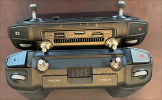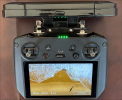For those of us that really enjoy flying from inside the car these mods mean a great deal. What is most important is Signal Strength because that goes hand in hand with Safety of flying your drone , so I am a fan.
With Range test coming to the end of an Era. We need to focus on other ways to test the Drones signal strength so I can fly with confidence , which is really what a range test is for . A one time charlie test to gain confidence in the drone.
My favorite was flying the
smart controller with no antennas out 2500 ft and getting disconnected , than turning on the
SC Alien Dual to see if it was really working and gaining back signal.
I also would point the
SC in the Opposite direction to see if I could maintain a signal. and the Ailen Tech Dual did well.
I am tempted to use My Alien Tech with the
Mavic 3 but have yet to test the Occu 3 to it limits do to VLOS rules.
What are some new ways we can test the Signal Strength without breaking the rules of VLOS. ?
I want to be able to fly behind rocks , go into gulley's , and caves and under tunnels and fly under the wave curls over the lake.
Phantomrain.org
Gear to fly in the Rain. Land on the Water.












